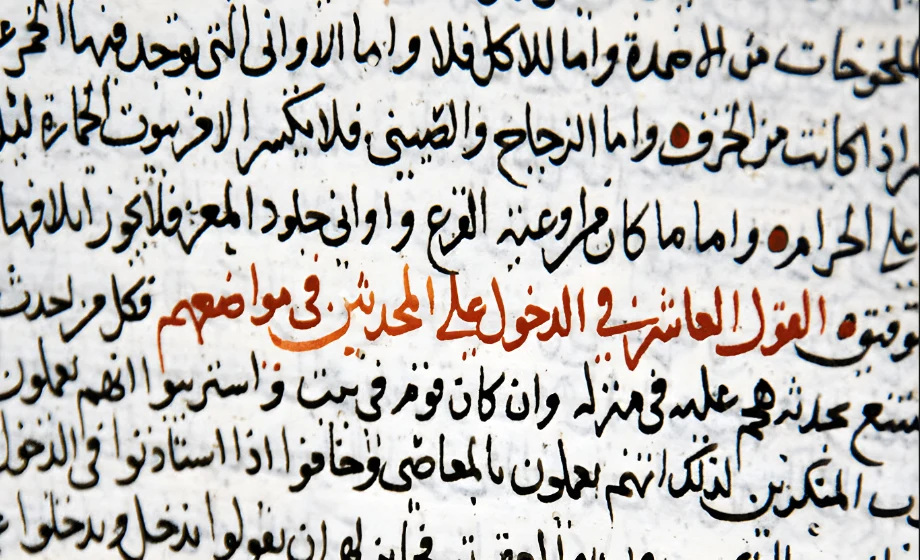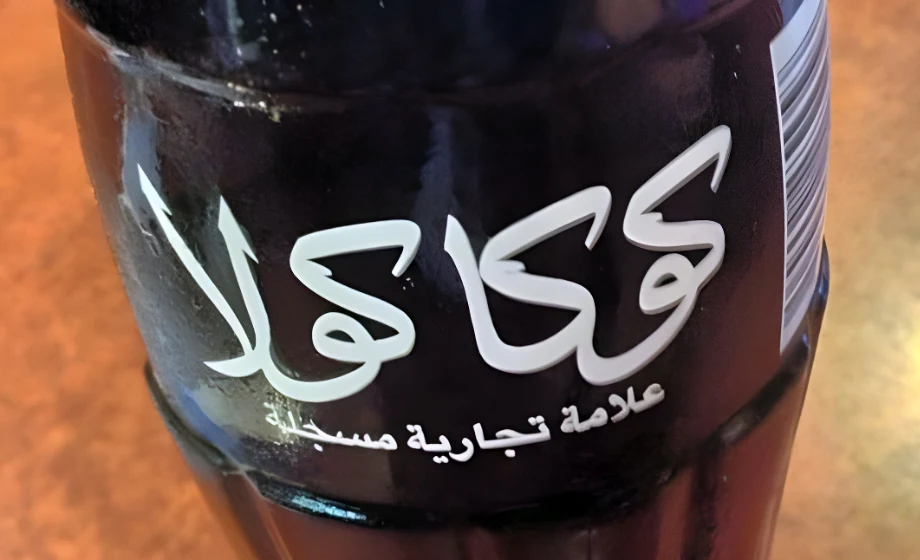Even in today’s digital age, translating handwritten Arabic documents – from doctor’s notes to calligraphy to legal documents like affidavits or police reports – remains a challenge. As with any language, the quality of penmanship can vary greatly from person to person and the reproduction (scan quality, photocopying, image resolution, etc) can also make a huge difference in a document’s legibility. Arabic handwriting translation can pose a challenge to your organization, but it doesn’t have to be a drain on your team’s time. Let Industry Arabic’s expert team handle your translation project involving handwritten Arabic documents. Our translation agency has an experienced and qualified team of translators and reviewers to get the job done fast and to a high standard. This article outlines some of the basic techniques needed to decipher handwritten Arabic texts and presents a few case studies of handwriting projects our team has completed.
Arabic Handwriting Basics
The Arabic alphabet (abjad) consists of 28 letters, each of which takes three different shapes depending on its placement in a word (front, middle, and end). Many of the letters share similar shapes and appearances, so diacritic dots and lines are placed either above or below the letters to distinguish them from one another. Arabic script is also unique from other world languages in that it is written from right to left. Unlike most European languages, which have upper and lowercase letters, as well as block and cursive letters, the Arabic language is only written in cursive. This allows for an extremely diverse range of handwriting styles that have developed over the centuries.
A Brief History of Arabic Handwriting
The Arabic script, like Greek, Hebrew, and other Mediterranean languages, derives its basic forms from the Phoenician writing system created between the 13th and 12th centuries BCE. The Nabataeans, an Arab tribal nation who settled in modern-day Jordan, modified this alphabet to suit their language in the 6th-5th century BCE, which eventually became the basis for modern Arabic script. There are few examples of pre-Islamic Arabic scripts still in existence, however, the oldest is from the early 6th century CE.
Most of these writings, including the earliest versions of the Qur’an, were usually written in a plain script known as rasm. This form of writing contains no diacritics, or tiny symbols added to the shape of similar-looking letters to distinguish one from the other. As such, it can be very difficult to read. At that time, however, important texts, such as the Quran, were memorized orally, so the basic skeletal structure of the rasm writing was secondary to the spoken and recited words. Yet, as the spread of Islam necessitated precise rendering of holy texts, especially for non-Arab converts, the practice of including diacritic dots under and above similarly-shaped letters became standard in the 7th and 8th centuries.
Tips for Reading Translating Handwritten Arabic
Here are some of the main ways in which Arabic handwriting may differ from Arabic print:
- Ligatures: Unlike in standard Arabic typing script, where all of the letters are neatly ordered next to each other in their normal position on the line, some letters form ligatures written by hand. This means that they are stacked on top of one another to conserve lateral space. The following chart from Wright’s grammar shows the most common ligatures found in handwritten Arabic:

- Alif (ا): Sometimes, especially in the definite article ال (“the”), the alif may appear below the word, instead of next to it:

- Alif maqsura (ى): When at the end of a word, sometimes the tail curls around to the right, instead of the left:

- Jiim (ج), Haa (ح), and Khaa (خ): When at the beginning of a word, these letters look like a triangle with the left side of the triangle dipping below the line. When in the middle of a word, the other letters stack on top of it (see ligatures above):
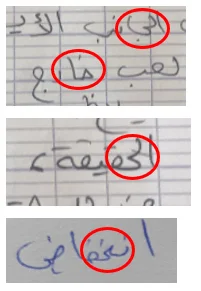
- Siin (س) and shiin (ش): For convenience’s sake, instead of drawing the three teeth, these letters are represented as straight lines when found in the middle of a word. When at the beginning of a word, it is sometimes written as an acute angle followed by a long straight line:
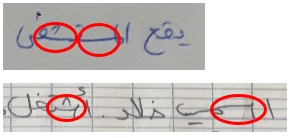
- Taa (ط) and Dhaa (ظ): Sometimes the long vertical line is not connected to the baseline:

- Miim (م): When in the middle of a word, it can sometimes be depicted as a round bump, as well as a tight loop. Letters also tend to stack on the miim when found in the middle position. When connected to the particle ال, the letter loops under or to the right of the laam:
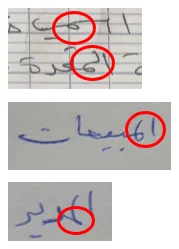
- Nuun (ن): In some cases, this letter can appear to look like an “N.” Conveniently enough, the nuun denotes the letter “n” in Arabic!:
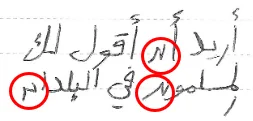
- Haa (ه): People usually write this intricate letter as a curly cue at the start of a word or a sharp dip below the line in the medial position:

- Diacritics: As stated above, Arabic diacritics come in the form of dots in typed Arabic. In handwritten Arabic, however, the dots are usually written as lines instead:
A straight line is used to represent two dots:

A caret sign (^) is used to represent three dots:
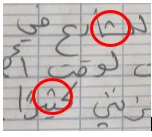
There are also certain types of documents we see on a regular basis that have handwriting present:
- Legal/Medical Forms: Some legal forms (e.g. civil registry forms and birth/death certificates) and medical forms (i.e. in-patient status forms, vaccination records, and prescriptions) have areas in which people must fill in the proper information by hand. As the allotted boxes or lines may themselves be tiny, to begin with, this could lead to cramped and illegible handwriting.
- Marginalia: In certain instances, some legal decisions have right-hand margins for lawyers to write in their own notes regarding the file’s contents.
- Affidavits: In some cases, a person may have to submit handwritten legal affidavits, such as deeds or wills, if they cannot do so by electronic means. These documents are permissible if notarized by the proper authorities.
- Notes: Again, if one does not have access to a computer or email (or for those who prefer a personal touch to correspondence), handwritten letters are still a common form of communication. These notes and letters can be especially difficult to read, as each person has their own personal penmanship style.
Our Approach to Arabic Handwriting Translation:
As a specialized translation company, we possess a number of advantages over traditional language services providers. As such, here are a few ways in which Industry Arabic stands out from the rest:
- 100% Expert Human Translators: OCR technologies are great for recognizing words in a printed document, but are severely lacking when trying to interpret handwriting. With Industry Arabic, however, we cut out the middle bot and employ our team of vetted and competent human translators, all of whom are familiar with the various styles of Arabic handwriting.
- Custom Client Support: We pride ourselves on our fast and attentive customer service. You can always count on our team to respond to any request fast. Plus, we are a worldwide team, so no matter what timezone you are in, we have people working around the clock on your project.
- Two-Step Verification: Our team guarantees that each translation goes through a two-step verification process to ensure its quality. Like most written works, translations go through rough draft stages. For some people, this is where the job ends. However, at Industry Arabic, our translators proofread and edit their work once they have finished the translation. Afterward, one of our bilingual editors will carefully conduct a second round of editing to polish the language, if necessary, and make the final translation presentable for the target audience.
Previous Handwriting Translation Projects:
- Arabic Handwritten Evidence Documents. Translated hundreds of pages of handwritten evidence materials in a North African dialect. Our team deciphered nearly all the text despite poor handwriting and scan quality.
- Project Finance. Support an international bank in English to Arabic translation of investment project files, press releases, and reports. Translate stakeholder materials from handwritten Arabic to English for analysis.
Send Us Your Handwriting Translation Today!
Getting started with your translation project is easy and affordable with Industry Arabic! Just use the orange button at the top right-hand portion of the screen to send us your project. You will receive a personalized quote from one of our team members within 30 minutes or less!
